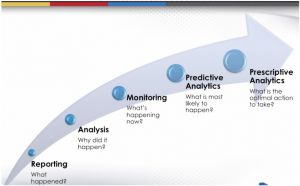Last week the Libraries’ Assessment Community of Practice kicked off the year by hosting Alexandra Yanovski-Bowers (Assistant Director for Undergraduate Strategic Initiatives) and Michele Lynn O’Conner (Associate Vice Provost for Undergraduate Studies). The discussion was Undergraduate Studies’ work to build a predictive statistical model for identifying “at risk” students at Temple and provide positive interventions to support these students.
While the idea of collecting, mining and analyzing personal data on students is concerning to some, Temple’s research program utilizes data already collected by the University as part of doing business, and uses very selected data points to target students who are at greater statistical risk of not returning to school at the beginning of the subsequent year. This is how “at risk” students are defined.
Alexandra described the various ways in which data can be used – we can collect it, we can watch the trends and report out on what’s happening. But we can also take a more “pro-active” approach to using the data that we are already collecting and use that data for supporting student success. This is predictive analytics.
In the course of its business, the University collects data related to admissions, enrollment, orientation registration, gpa, housing, financial aid, as well as its New Student Questionnaire, completed by all incoming students. The modeling process uses historical data to make a determination of the key variables within these data sets that correlate with a students not returning. That “model” is applied to the current student population to identify students potentially at risk. This means that the model is constantly changing as the student population and policies for administration and registration change.
Undergraduate Studies wanted to be more pro-active in helping students – not stepping back and waiting for students to seek assistance on their own. So prior to any data work, the University beefed up its advising program. Each school as a risk adviser, and those advisers all undergo Risk Liaison Intervention Training. There are a variety of interventions to meet a student’s particular need. The intervention may be extra academic advising, but it is as likely to result in a job closer to campus, or a specialized financial aid workshop.
From the floor there were questions about how confidentiality of students was protected. For the Library, a core value is protecting confidentiality of the individual in terms of what they read or the information they access. We talked of the responsible ways of using predictive analytics. The fact that Temple has created its own model means less risk of external parties getting access to student data.
What might the Library’s role be? Students don’t always know how the librarian fits into their educational experience. To that, Alexandra says, “We want the library to be an intervention, not a factor. “ In other words, we serve a greater purpose by connecting with students, providing space for their work, advising on their research, and being a friendly face as they face the stresses of being a college student on this big campus.


Thank you for organizing this Nancy! I think these conversations are so important. My thinking on this issue has been highly influenced by the excellent writing of Audrey Watters. I highly recommend that folks check out her work, and in particular, a talk she gave at Columbia several years ago entitled, “Student Data is the New Oil.” (http://hackeducation.com/2013/10/17/student-data-is-the-new-oil)